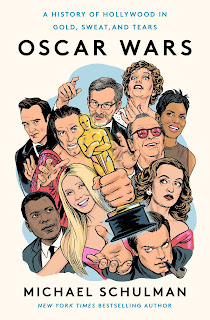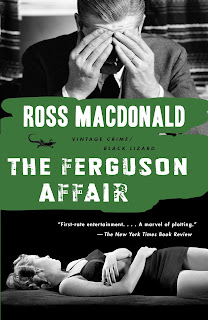I’m on strike at the moment, and that moment may last a while. Might as well keep limber by making a few recommendations.
What I’m Watching
Rabbit Hole (Paramount+). I waited until all eight episodes of the first (only?) season of this show dropped to make sure it stuck the landing. It did, so now I can say this Kiefer Sutherland series is the best thing I’ve seen on TV in a while, and stronger than any thriller novel I’ve read recently. And I won’t tell you why.
Doing so would spoil the fun. More than one episode of
Rabbit Hole ended with a reveal that had me saying “What the
fuck?” aloud to my TV. But every twist feels organic, thanks to the show’s devilishly intricate structure and to its premise. Sutherland’s John Weir specializes in shaping perceptions to aid his corporate clients, his tactics and slippery morals perfectly illustrated in the extended sequence that opens the premiere episode; right off the bat, you’re advised not to trust what you see. An old friend hires Weir and his team for a job that ends with Weir framed for murder. Where the show goes from there is … well, you’ll have to watch for yourself.
Rabbit Hole is consistently funny, which shouldn’t have surprised me considering it’s the brainchild of Glen Ficarra and John Requa (
Bad Santa). They write beautifully for Sutherland, wringing laughs out of his gruff persona. The show’s sensibility and Weir’s character are established in this early exchange between Weir and the FBI agent determined to take him down.
FBI Agent: Corporate espionage is a dirty way to get rich.
Weir: Espionage? What are you talking about? I’m not a spy.
FBI Agent: Manipulating people and situations to influence markets for client advantage is … what, then?
Weir: Consulting.
A sequence when Weir, the target of a city-wide manhunt, strolls into a New York police station to see the “evidence” against him is a marvel of low-tech deception and social engineering. And a running gag involving Kiefer and hammers got me every time.
But the show also succeeds as a thriller, tackling thorny topical subject matter in a manner that consistently raises the stakes. The supporting cast is richly idiosyncratic, and when the actor playing the show’s Big Bad finally showed their face, I was ecstatic. (And even
that reveal has a reveal.) If the show doesn’t return, its sole season goes into the books a winner, ending on a perfect note of 1970s-style paranoia.
Paramount+ may be primarily known for
Yellowstone and
Star Trek spinoffs, but it’s also the home of
The Offer (
my favorite show of 2022) as well as the bonkers Catholic
X-Files, better known as
Evil. That’s a solid batting average for a streaming service.
Transatlantic (Netflix). I wrote about it in my guise as
Renee Patrick, but nowhere near enough people are paying attention to this lush limited series, so I’ll also laud it here. It’s about the ragtag efforts of the Emergency Rescue Committee to transport artists from Europe to the United States in 1940. Like
Rabbit Hole, it employs a tone you don’t expect; it’s light and even fizzy, which only lends the dark moments more impact. Watch it for Justine Seymour’s costumes, each and every one a knockout, and the haunting score by Mike Ladd & David Sztanke.
What I’m Reading
The Pitfall, by Jay Dratler (1947). The 1948 film noir
Pitfall has been rediscovered, due in part to the efforts of my friend and colleague
Eddie Muller. It also stands out by having a femme fatale who’s no seductress, but a woman simply trying to do her best. It’s not the fault of Mona, played by Lizabeth Scott, that men are drawn to her, like bored suburban family man/insurance investigator Forbes (Dick Powell) and sleazy stalker shamus Mac (Raymond Burr). The source novel is by Jay Dratler, who didn’t work on the film but whose own impressive string of noir credits includes
the Hitchcock knockoff Fly-by-Night (1942) and
Laura (1944). Dratler’s book is back in print, part of
Stark House Press’s Film Noir Classics line. (Hat tip to
Saturday Evening Post columnist
Bob Sassone for reminding me about this series.) Reading it is an object lesson in adapting material, particularly under the strictures of the Production Code.
Which is ironic, given that in the novel, Forbes is no insurance man but a screenwriter. Mac isn’t a private eye but a Beverly Hills cop. He had a hand in arresting Mona’s purse-snatcher husband and wants to make a move on her, but knows he doesn’t stand a chance … unless his buddy Forbes, whose wife is currently very pregnant, sleeps with her first, then vouches for good ol’ Mac. Nothing that sleazy or disturbing occurs in the film version; in the 1940s, it never could. Mona remains the same, a goodhearted woman powerless before her power over men.
The book is packed with vintage Hollywood detail. Forbes says of Schwab’s: “It’s movie-town’s drugstore, and better stories are enacted at its counters and in the rear of the prescription counter than many a studio shapes into its best product.” Toiling on assignment at Fox while he agonizes over Mona, he thinks, “I knew I’d lick the story. I never met one that couldn’t be pounded into shape if you beat your head against it long enough and if you made real people live in it.” Dratler certainly did that here.
The Pitfall is a close-quarters study of obsession, as short and sharp as a kidney punch. And it features an extended metaphor involving a centipede that’s still wriggling away in my brain.
What I’m Drinking
I discovered this Martinez riff courtesy of Cocktails with Suderman and was sold on it before sip #1 because:
a) it’s concocted by genius bartender Phil Ward, whom I’ve had the pleasure of seeing in action at the New York bars Death & Co. and Mayahuel and who has gifted us with modern classics like the Oaxaca Old Fashioned and the Final Ward;
b) it features the artichoke-heavy amaro Cynar, a personal favorite;
c) it’s named after a modern noir classic. Forget it, reader, it’s …
Cynartown
2 oz. London dry gin
¾ oz. sweet vermouth (Ward recommends Carpano Antica)
½ oz. Cynar
Stir. Strain. Garnish with a Luxardo maraschino cherry.























